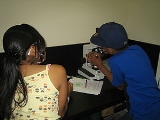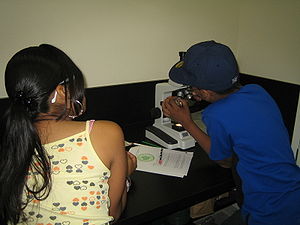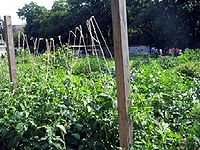
Project Green Reach
Encyclopedia

Brooklyn Botanic Garden
Brooklyn Botanic Garden is a botanical garden in the borough of Brooklyn in New York City. Located near the Prospect Heights, Crown Heights, and Park Slope neighborhoods, the garden includes a number of specialty "gardens within the Garden," plant collections, and the Steinhardt Conservatory,...
, which is a world-renowned botanical garden
Botanical garden
A botanical garden The terms botanic and botanical, and garden or gardens are used more-or-less interchangeably, although the word botanic is generally reserved for the earlier, more traditional gardens. is a well-tended area displaying a wide range of plants labelled with their botanical names...
located in Brooklyn, New York. PGR is estimated to reach 2,500 students annually in Brooklyn's most under-served neighborhoods. Funding for PGR comes mostly from private grant
Grant (money)
Grants are funds disbursed by one party , often a Government Department, Corporation, Foundation or Trust, to a recipient, often a nonprofit entity, educational institution, business or an individual. In order to receive a grant, some form of "Grant Writing" often referred to as either a proposal...
s. This allows the programs that operate under the auspices of PGR to be very inexpensive and accessible.
School year programming
During the school year, Project Green Reach instructors partner with classroom teachers in BrooklynBrooklyn
Brooklyn is the most populous of New York City's five boroughs, with nearly 2.6 million residents, and the second-largest in area. Since 1896, Brooklyn has had the same boundaries as Kings County, which is now the most populous county in New York State and the second-most densely populated...
's Title I schools. During the course of the school year, PGR works with 80 classes of students, grades kindergarten through eighth grade. Each class of PGR participants has three sessions with PGR: one school visit in which the students participate in a botanically oriented workshop during which each student gets their own plant to keep for ongoing study, one visit to the garden
Brooklyn Botanic Garden
Brooklyn Botanic Garden is a botanical garden in the borough of Brooklyn in New York City. Located near the Prospect Heights, Crown Heights, and Park Slope neighborhoods, the garden includes a number of specialty "gardens within the Garden," plant collections, and the Steinhardt Conservatory,...
in which the students explore the plants that are on display and participate in some hands-on activities in the greenhouses, and a final, culminating, school visit in which the students perform a horticulture-based community service project. In addition, PGR runs two more professional development workshops for the participating teachers.
Currently, PGR offers four curricula for their classroom visit workshops: life cycle of a bulb
Bulb
A bulb is a short stem with fleshy leaves or leaf bases. The leaves often function as food storage organs during dormancy.A bulb's leaf bases, known as scales, generally do not support leaves, but contain food reserves to enable the plant to survive adverse conditions. At the center of the bulb is...
, kitchen botany
Botany
Botany, plant science, or plant biology is a branch of biology that involves the scientific study of plant life. Traditionally, botany also included the study of fungi, algae and viruses...
, desert
Desert
A desert is a landscape or region that receives an extremely low amount of precipitation, less than enough to support growth of most plants. Most deserts have an average annual precipitation of less than...
environments, and the tropical rainforest
Tropical rainforest
A tropical rainforest is an ecosystem type that occurs roughly within the latitudes 28 degrees north or south of the equator . This ecosystem experiences high average temperatures and a significant amount of rainfall...
.
Summer program

The accepted applicants then participate in Project Green Reach's six-week summer program, which is divided into two smaller subsections: the Junior Botanist program, and the Plant Investigator program. First-time students are automatically placed into the Junior Botanist program, which is specifically designed for children who have little or no horticultural or botanical experience. Junior Botanists are then given the opportunity to reapply and become Plant Investigators for a second summer. Since Plant Investigators have some prior experience, their curriculum is usually more focused on life sciences. Junior Botanists and Plant investigators spend the morning together, typically working on their plots in the Children's Garden, and have separate lessons after lunch.

